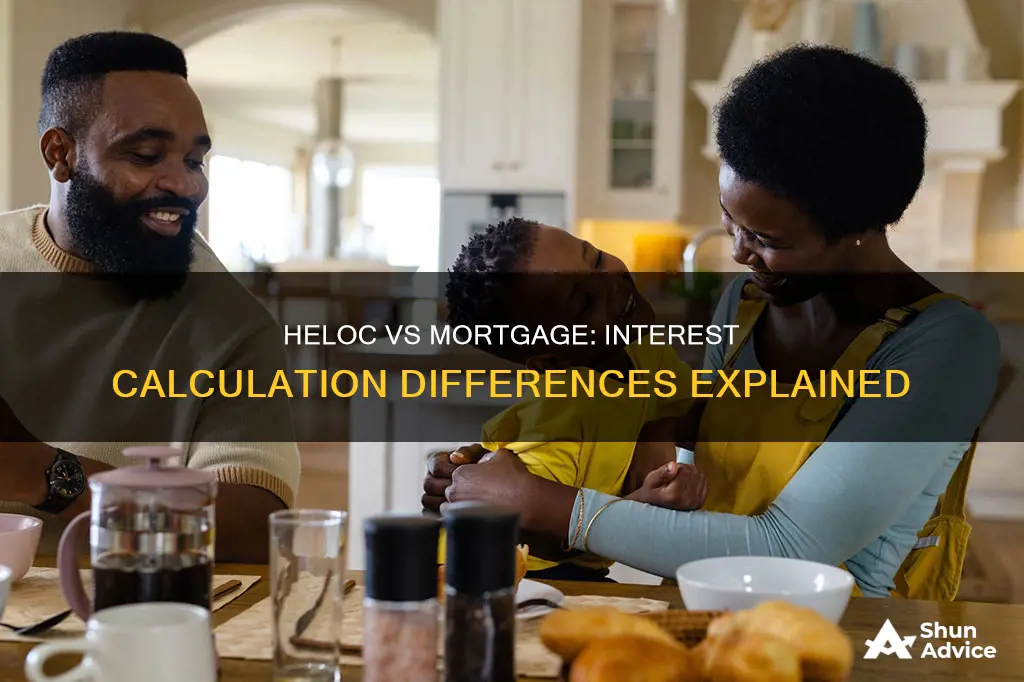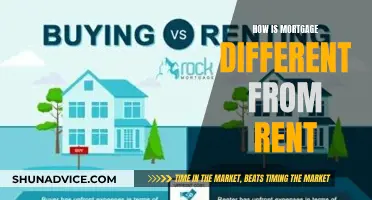
Interest rates are a significant factor in determining the affordability of loans such as mortgages and HELOCs. Interest rates on these loans are calculated differently, with mortgage interest calculated as a percentage of the remaining principal, while HELOC interest is calculated daily based on a variable interest rate. Understanding how interest is calculated on these loans is crucial for borrowers to make informed financial decisions and effectively manage their repayments.
HELOC vs Mortgage
| Characteristics | Values |
|---|---|
| Definition | HELOC is a line of credit that uses the equity in your home as collateral. A mortgage is a loan used to finance the purchase of a home. |
| Repayment Structure | HELOCs have a draw period, during which you pay interest, followed by a repayment period during which you pay the outstanding balance plus interest. Mortgages are repaid on a fixed schedule over 15-30 years, with monthly payments consisting of principal and interest. |
| Interest Rate | HELOCs usually have variable interest rates that change with the market. Mortgages can be fixed or variable interest rates. |
| Loan Amount | HELOC loan amounts are limited by the value of the home and are usually smaller than mortgage amounts. |
| Collateral | Both HELOCs and mortgages use the home as collateral. |
| Repayment Flexibility | HELOCs offer more flexible repayment terms than mortgages. |
| Purpose | HELOCs can be used for various purposes, such as home repairs, debt consolidation, or other large expenses. Mortgages are specifically designed for purchasing, building, or refinancing real estate. |
| Interest Calculation | HELOC interest is calculated daily due to potential changes in the balance, while mortgage interest is typically calculated monthly. |
| Closing Costs | HELOCs may have closing costs ranging from 2% to 5% of the loan amount, while mortgages often involve closing costs as well. |
| Annual Fees | HELOCs may charge annual fees, typically around $50 per year. Mortgages may also involve annual fees, depending on the lender. |
What You'll Learn
- HELOCs have variable interest rates, unlike mortgages which are usually fixed
- Interest on a HELOC is calculated daily, while a standard mortgage calculates it monthly
- HELOCs are secured against the value of your home, so interest rates are lower than personal loans
- HELOCs are considered second mortgages, and interest rates are tied to the prime rate
- Interest rates on HELOCs can be locked in, but this is not common

HELOCs have variable interest rates, unlike mortgages which are usually fixed
A home equity line of credit (HELOC) is a type of loan that uses the equity in your home as collateral. It is often considered a second mortgage. With a HELOC, you can borrow a portion of your equity and spend it on anything you like. The loan is typically structured as a line of credit, which means you can draw upon the loan funds as needed, up to a pre-approved credit limit.
HELOCs usually have variable interest rates. This means that monthly payments could go up or down depending on changes in the market, the amount borrowed, and other factors. The variable rate is calculated from both an index and a margin. An index is a financial indicator used by banks to set rates on many consumer loan products. Most banks, including Bank of America, use the U.S. Prime Rate as published in The Wall Street Journal as the index for HELOCs. The index, and consequently the HELOC interest rate, can move up or down. Because the balance of a HELOC may change from day to day, depending on draws and repayments, interest on a HELOC is calculated daily rather than monthly.
Mortgages, on the other hand, are loans used to finance the purchase of a home, typically over 15 to 30 years, with monthly payments consisting of principal and interest. Most people take out fixed-rate mortgages, which means that their monthly payments will remain the same for the life of the loan. That may make it easier to budget mortgage payments. However, unlike HELOCs, mortgages are not revolving lines of credit, so you cannot borrow funds, pay them off, and then borrow them again.
BBVA's Mortgage Services in Arizona: Pros and Cons
You may want to see also

Interest on a HELOC is calculated daily, while a standard mortgage calculates it monthly
A HELOC, or Home Equity Line of Credit, is a type of loan that uses the equity in your home as collateral. It is often considered a second mortgage and usually has a variable interest rate. Most HELOCs have a draw period, during which you can borrow money against your home equity and make interest-only payments. The interest on a HELOC is calculated daily, and the variable rate is based on an underlying index rate, which is a benchmark rate that reflects the general economy. Lenders add a markup, called a margin, to the index rate. For example, if the prime rate is 7.75% and the lender charges a 1% margin, the HELOC interest rate would be 8.5%. This rate will fluctuate as the prime rate changes.
On the other hand, a standard mortgage is a loan used to finance the purchase of a home, typically over 15 to 30 years, with monthly payments consisting of principal and interest. Fixed-rate mortgages are common, meaning that monthly payments remain the same for the life of the loan, making it easier to budget. The interest on a standard mortgage is calculated monthly, and the interest rate remains fixed for the term of the loan.
The difference in how interest is calculated for HELOCs and standard mortgages is due to the nature of the loans. A HELOC balance may change from day to day, depending on draws and repayments, while a standard mortgage typically has a fixed schedule of monthly payments. As a result, the interest on a HELOC is calculated daily, taking into account the average daily balance, while the interest on a standard mortgage is calculated monthly based on the loan balance at the end of the preceding month.
It is important to note that HELOCs carry a higher risk of interest rate fluctuations, as they are directly tied to the prime rate. While this can work in the borrower's favour when the prime rate is low, it can also lead to significant increases in the interest rate if market rates rise. Therefore, while HELOCs offer flexibility and easy access to cash, they also come with the risk of higher interest rates and the potential for significant debt if not managed carefully.
Consumer Direct Mortgage: A Smart Homebuying Move
You may want to see also

HELOCs are secured against the value of your home, so interest rates are lower than personal loans
A HELOC, or Home Equity Line of Credit, is a line of credit secured by your home. It gives you a revolving credit line to use for large expenses or to consolidate higher-interest-rate debt on other loans. HELOCs are secured against the value of your home, and the house is used as collateral for the line of credit. This means that if you fail to repay the money, the lender can place a lien on your home, which is a legal claim against the property that allows them to seize and sell the asset to recover the amount loaned.
HELOCs are often considered a second mortgage and usually have a variable interest rate. The interest rate on a HELOC is calculated daily rather than monthly, and it can be adjusted upward or downward. The variable rate is calculated from both an index and a margin. The index is a financial indicator used by banks to set rates on many consumer loan products, and the margin is negotiated between the lender and the borrower. The interest rate on a HELOC can change from month to month, and it is tied to the prime rate, which some argue is more stable than the indexes used by standard adjustable-rate mortgages.
Because HELOCs are secured by the value of your home, they typically have lower interest rates than unsecured debt like credit cards and personal loans. The interest rate on a HELOC is often lower than other forms of credit, and the interest paid may be tax-deductible, although you should consult a tax advisor regarding interest deductibility as tax rules may change. With a HELOC, you only pay interest on the portion of the line of credit that you use, and the interest rate is typically lower than the interest rate on a standard mortgage.
Compared to a mortgage, a HELOC can be a more flexible option as it allows you to borrow and repay money as needed, similar to a credit card. However, the variable interest rate on a HELOC can make it difficult to predict what your payments will look like in the long term, so it can be tricky to budget for. Additionally, the interest rate on a HELOC can change quickly in response to changes in the market, so there is a higher interest rate risk compared to a fixed-rate mortgage.
Understanding Mortgage Payment Strategies and Management
You may want to see also

HELOCs are considered second mortgages, and interest rates are tied to the prime rate
A HELOC, or Home Equity Line of Credit, is a line of credit borrowed against the available equity of a home. The home acts as collateral for the line of credit. HELOCs are often considered second mortgages, as they function similarly to a traditional second mortgage, with the home used as collateral. However, there are some key differences.
HELOCs have variable interest rates, which means the monthly payments can fluctuate. The interest rate is tied to the prime rate, which is influenced by the Federal Reserve's monetary policy. When the Federal Reserve changes the federal funds rate, the interest rate that banks charge each other for overnight loans, it impacts the prime rate, which is the rate that banks offer their most favoured clients. This, in turn, affects the HELOC interest rate. The variable interest rate of a HELOC means that the cost of borrowing can rise or fall in line with the federal funds rate. This is calculated daily, rather than monthly, and can change from day to day, depending on draws and repayments.
The interest rate on a HELOC is calculated differently from a standard mortgage. On a standard mortgage, the interest for the month is calculated by dividing the interest rate by 12 and multiplying it by the loan balance. On a HELOC, the interest rate is divided by 365 and multiplied by the average daily balance for the month. This means that the interest rate on a HELOC can be more volatile and responsive to market changes.
The interest rate on a HELOC can be lower than other forms of credit, and the interest paid may be tax-deductible. However, it is important to note that the interest rate risk is a significant disadvantage of HELOCs. As adjustable-rate mortgages, they are subject to changes in the market, which can impact the interest rate very quickly. While the prime rate may be seen as more stable than other indexes, it can still change frequently, and a rise in market rates can quickly turn an advantage into a disadvantage.
HUD Mortgage Policy: Fueling the Housing Crisis
You may want to see also

Interest rates on HELOCs can be locked in, but this is not common
A HELOC, or Home Equity Line of Credit, is a revolving line of credit with a variable interest rate. The interest rate on a HELOC is usually variable and can change from month to month, which can make it difficult for borrowers to predict their monthly payments. However, some lenders do offer the option to lock in a fixed interest rate on a HELOC, which can provide more predictability and stability for borrowers.
While locking in a fixed interest rate on a HELOC can provide stability, it is important to note that this option is not common. Fixed-rate HELOCs are a relatively new product, and not all lenders offer them. Additionally, fixed-rate HELOCs typically come with higher initial interest rates and may have higher origination and maintenance fees than variable-rate HELOCs. There may also be additional fees and penalties associated with locking in a fixed rate, such as annual fees, rate lock fees, and penalties for not following the terms of the loan.
One of the main advantages of locking in a fixed interest rate on a HELOC is that it provides borrowers with predictable monthly payments. This can be especially beneficial for borrowers who are using the HELOC for home improvements or other planned expenses, as it allows them to have certainty about the cost of their financing. Additionally, with a fixed-rate HELOC, borrowers are protected against market fluctuations that can impact variable interest rates.
It is important to note that the decision to lock in a fixed interest rate on a HELOC depends on various factors, including the current market rates and the borrower's financial goals. For example, if mortgage rates are projected to drop, borrowers might be better off with a traditional variable-rate HELOC that can adjust downward if rates do drop. On the other hand, if rates are forecasted to increase, locking in a fixed rate can help borrowers secure a lower rate before that happens.
Overall, while it is possible to lock in a fixed interest rate on a HELOC, this option is not common and may come with additional costs and considerations. Borrowers should carefully weigh the benefits and drawbacks of a fixed-rate HELOC and consult with a financial advisor to determine if it is the right choice for their specific situation.
Understanding Mortgage Payments: How High is Too High?
You may want to see also
Frequently asked questions
HELOC stands for Home Equity Line of Credit. It is a line of credit secured by your home that gives you a revolving credit line to use for large expenses or to consolidate higher-interest-rate debt on other loans.
Most HELOCs have variable interest rates that are calculated daily and are based on an underlying index rate. This means that as baseline interest rates go up or down, the interest rate on your HELOC will adjust too.
A mortgage is a loan used to finance the purchase of a home, typically over 15 to 30 years, with monthly payments consisting of principal and interest.
Mortgages usually have fixed-interest rates, meaning that monthly payments will remain the same for the life of the loan.
HELOCs are considered second mortgages and are often used to consolidate debt or make home improvements. They have variable interest rates and greater exposure to interest rate risk. On the other hand, mortgages are usually the first loan taken out to purchase a home and have fixed-interest rates with less flexibility in repayment terms.







